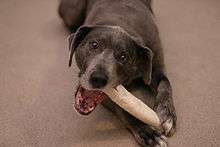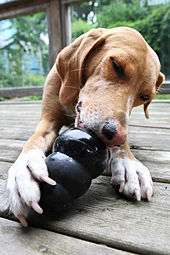Chew toy
A chew toy is designed to be chewed by animals for purposes of stimulation and relief from boredom.[1] The act of gnawing on a chew toy is meant to be soothing and to assist small animals, like puppies, in event of easing the pain when breaking in their adult teeth as the chewing process releases feel-good chemicals from the brain.[2] There are several different types of chew toys, including rawhide, wood, paper and mineral. Chew toys are commonly associated with dogs, though they are also used by birds, rodents, and rabbits.
In addition to providing entertainment, chew toys allow the animal to work out anxiety and boredom by being occupied with chewing a toy. Chew toys also distract small animals from chewing on other "forbidden" items, and they assist in maintaining healthy teeth.[3]
A similar toy called a teether is also given to human children as a soothing tool for inflamed gums during teething.
Rawhide

Rawhide chew toys are most often associated with dogs, though rawhide toys are plentiful in the bird toy section of most pet stores. Rawhide is suitable for all animals except herbivores, as it is made of animal skin. Rabbits, which only eat vegetation, cannot have rawhide toys because their digestive systems cannot process them. This is a rather sturdy kind of chew toy and it can take months for a small animal or bird to destroy. Examples of rawhide chew toys are twists and rawhide bones. Chew toys made of leather are not recommended for dogs as they cannot be properly digested in the stomach and may cause blockage in the intestines.[4]
Wood
Wood chew toys are made of a safe, non-poisonous, softer wood and are often coated in bright, vegetable-based dyes or paints. Wooden chew toys are given in place of the wood that small animals would find in the wild. They are a safe alternative for a small animal owner to purchase if the owner has no knowledge of the trees and shrubs growing in their area. They are generally used as either small rodents toys or rabbit toys. Wooden chew toys help to keep teeth trimmed down, preventing eating difficulties in pets and unnecessary trips to a vet for teeth clipping. An example of a wooden chew toy is the commercial product toy ropes
Paper
Paper chew toys are made of non bleached non-toxic paper. They are an inexpensive, or often free, option for small pet owners and can provide hours of stimulation and play for small animals. One common paper chew toy is an empty toilet paper tube. These can double as tunnels for very small rodents, and can also be used as modified piñatas for larger small animals. Wadded up newspaper pages, old spineless books, and the commercial product Chubes are other commonly used paper chew toys.
Mineral
Mineral chew toys are made of flavored animal-safe minerals. These range from flavored fruit-shaped blocks for birds to ice-cream cone shaped mineral treats for rabbits. They also come shaped as bowls with fluffy minerals inside. A common mineral chew toy is the cuttlebone, a toy for birds that helps to keep nails and beaks trimmed and healthy.
Rubber

There is a variety of rubber chew toys for dogs on the market that are molded into different shapes. Some of them are hollowed so that treats can be placed in them. This way, the dog has to "work" to get a treat.
References
- US patent 5477815, Anthony O'Rourke, "Dog chew toy", issued 1995-12-26
- "How to Prevent Puppy Chewing Problems". Thriving Canine. 2013-02-07. Retrieved 2020-01-12.
- Lynn Smith, Chandra (2009-04-19). "Use chew toys, leash to help train puppies". The Evening Sun. Archived from the original on 2009-09-03. Retrieved 2009-05-02.
- Parent, Lucia E.; Lucia Roesel-Parent (2003). Beagles: Everything about Purchase, Care, Nutrition, Handling, and Behavior. Barron's Educational Series. p. 23. ISBN 0-7641-2002-6.